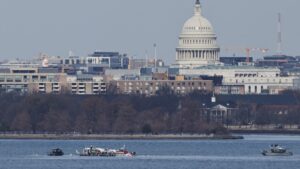Tragedy Over the Potomac: The Collision of American Eagle Flight 5342 and a Military Helicopter
On the evening of January 30, 2025, a catastrophic incident unfolded in the skies over the Potomac River, forever etching its grim mark on aviation history. An American Eagle flight collided with an Army Black Hawk helicopter, resulting in the tragic loss of all 67 individuals onboard. This incident, occurring near the bustling Reagan National Airport, stands as the deadliest U.S. air crash in over two decades, raising a host of questions about air traffic safety protocols, particularly in high-density flight corridors.
The Collision: What We Know So Far
The ill-fated flight, American Eagle 5342, operated by PSA Airlines, was descending at approximately 300 feet in preparation for landing on Runway 33 when it encountered the Black Hawk helicopter. Eyewitness reports and emerging evidence reveal the helicopter was on a routine proficiency training mission, a common operation that is supposed to avoid high-traffic areas to ensure safety.
- Altitudinal Enigma: Investigators are trying to ascertain whether the military helicopter exceeded the contractual 200 feet altitude limit specified by the Federal Aviation Administration (FAA). Scrutiny is particularly high because military helicopters routinely traverse this airspace, which features designated flight tracks to manage helicopter movement alongside commercial flight paths.
The Fallout: Regulatory Implications & Response
The aftermath of the crash has spurred immediate regulatory changes. In a swift response to the incident, the FAA has implemented new flight restrictions in the Washington, D.C. airspace, limiting helicopter operations and placing stricter guidelines for future training flights. Extreme Investor Network has learned that these new regulations will likely remain in effect until the completion of the National Transportation Safety Board (NTSB) investigation, which is ongoing.
Defense Secretary Pete Hegseth remarked that the incident was “tragic” and hinted at an ongoing inquiry into the altitude management of military helicopters operating in busy sectors. He stated, “There was some sort of an elevation issue.” This pointed commentary reflects the growing concern over the possible lapses in strict adherence to altitude regulations.
A Historic Perspective: Safety Measures in U.S. Aviation
Historically, the aviation industry has made substantial strides in safety following prior crashes; notably, there hasn’t been a fatal commercial aviation accident in the U.S. since 2009, despite a significant surge in air traffic. The looming question remains: what can the authorities and the aviation community implement to ensure that this streak of safety isn’t jeopardized?
Extreme Investor Network suggests that broadcast innovations in Real-Time Traffic Awareness Systems (RTAS) could play a crucial role in improving airspace deconfliction between helicopters and fixed-wing aircraft in heavily-traveled areas.
Dissecting the Investigation: The Road Ahead
The NTSB is firmly at the helm of this investigation, sifting through flight data and cockpit voice recorders extracted from the wreckage. These vital pieces of information will shed light on the circumstances leading to the tragic event. Jennifer Homendy, NTSB Chair, emphasized the importance of thoroughness, stating, “We have substantial amounts of information. We need to verify information and ensure accuracy."
Interestingly, reports have surfaced regarding staffing shortages at the Reagan National control tower during the time of the incident, potentially impacting the oversight of helicopter traffic. While FAA guidelines permit a single controller to manage both helicopter and airplane traffic, it’s evident that the complexity of this arrangement demands reevaluation, especially in high-density airspace.
The Path Forward: Learning from Tragedy
As investigations unfold, it is vital for all stakeholders in aviation—from regulators to the military to airline operators—to take a collective step back and reflect on the operational protocols that govern air traffic management.
At Extreme Investor Network, we believe in the mantra that every incident is a lesson learned. Following the preliminary findings regarding staffing and airspace management, a robust review of protocol and technology integration is essential for preventing future tragedies.
In a world increasingly reliant on air travel, ensuring safety and efficiency must take precedence. The collision of Flight 5342 and the Black Hawk helicopter is not just a reminder of the fragile nature of air safety; it is a call to action to bolster the systems that keep our skies safe.
Stay Informed with Extreme Investor Network
For continued insights into aviation safety developments and implications for the investment landscape, stay tuned to Extreme Investor Network as we keep you updated with comprehensive and exclusive content you won’t find anywhere else.

